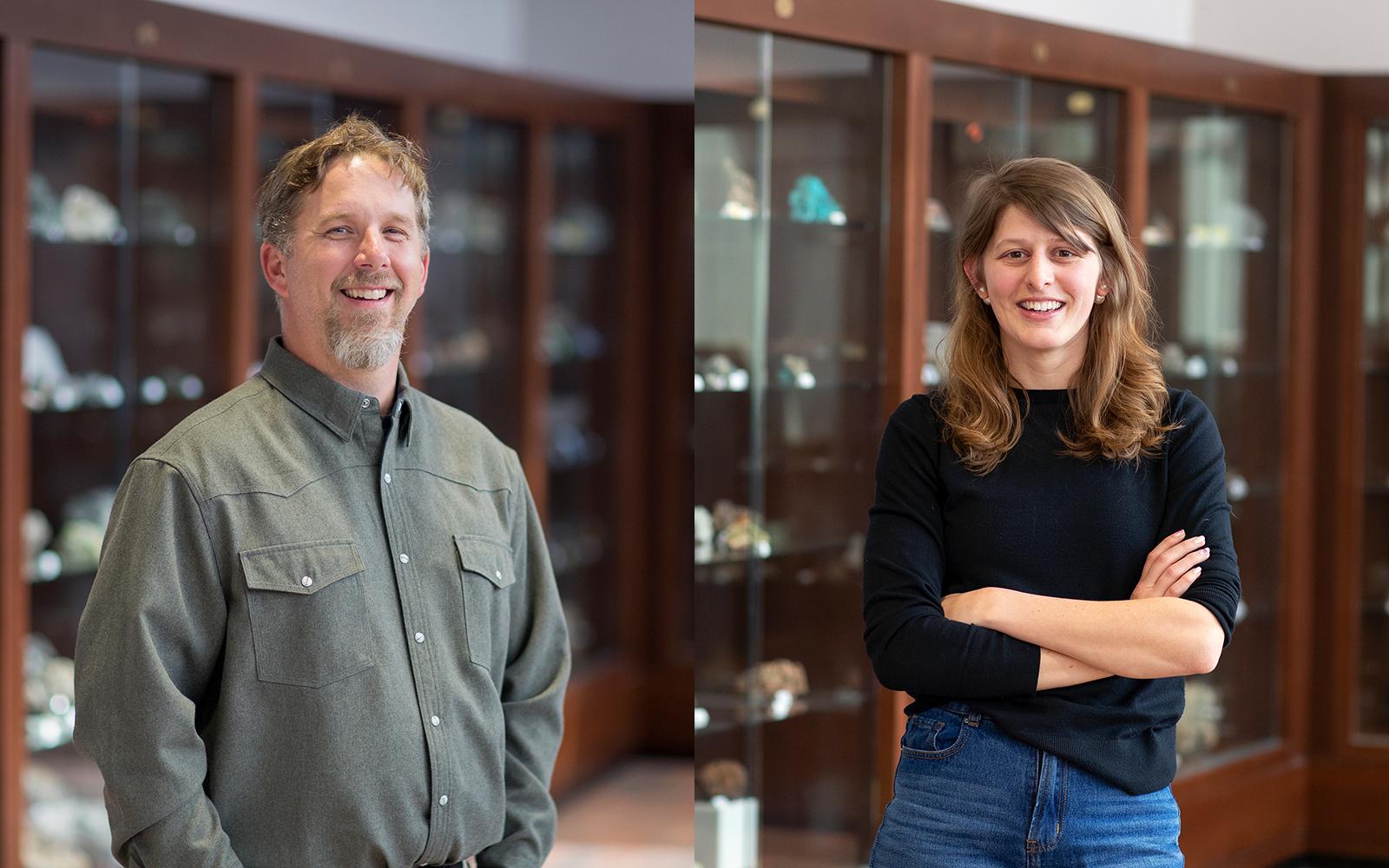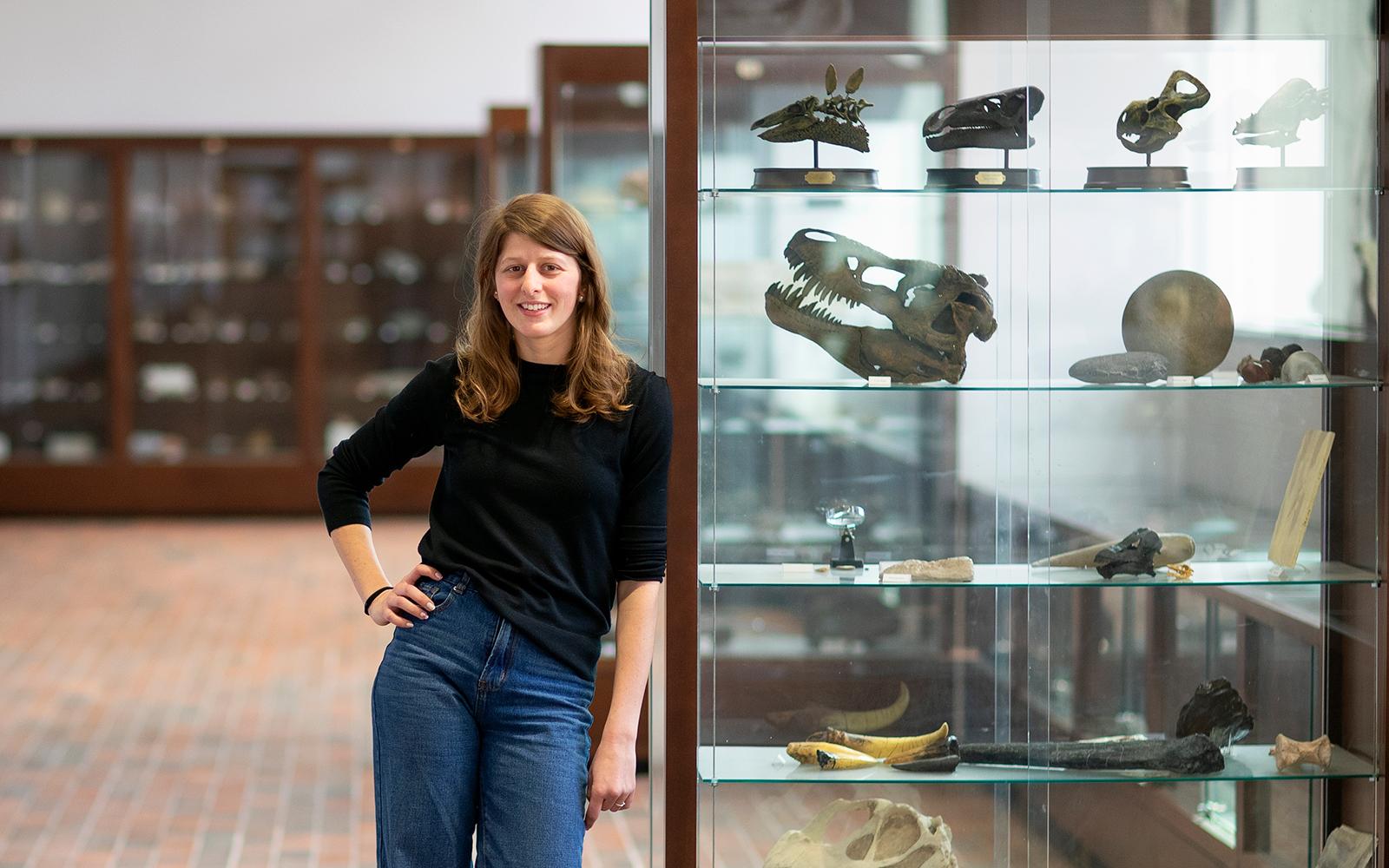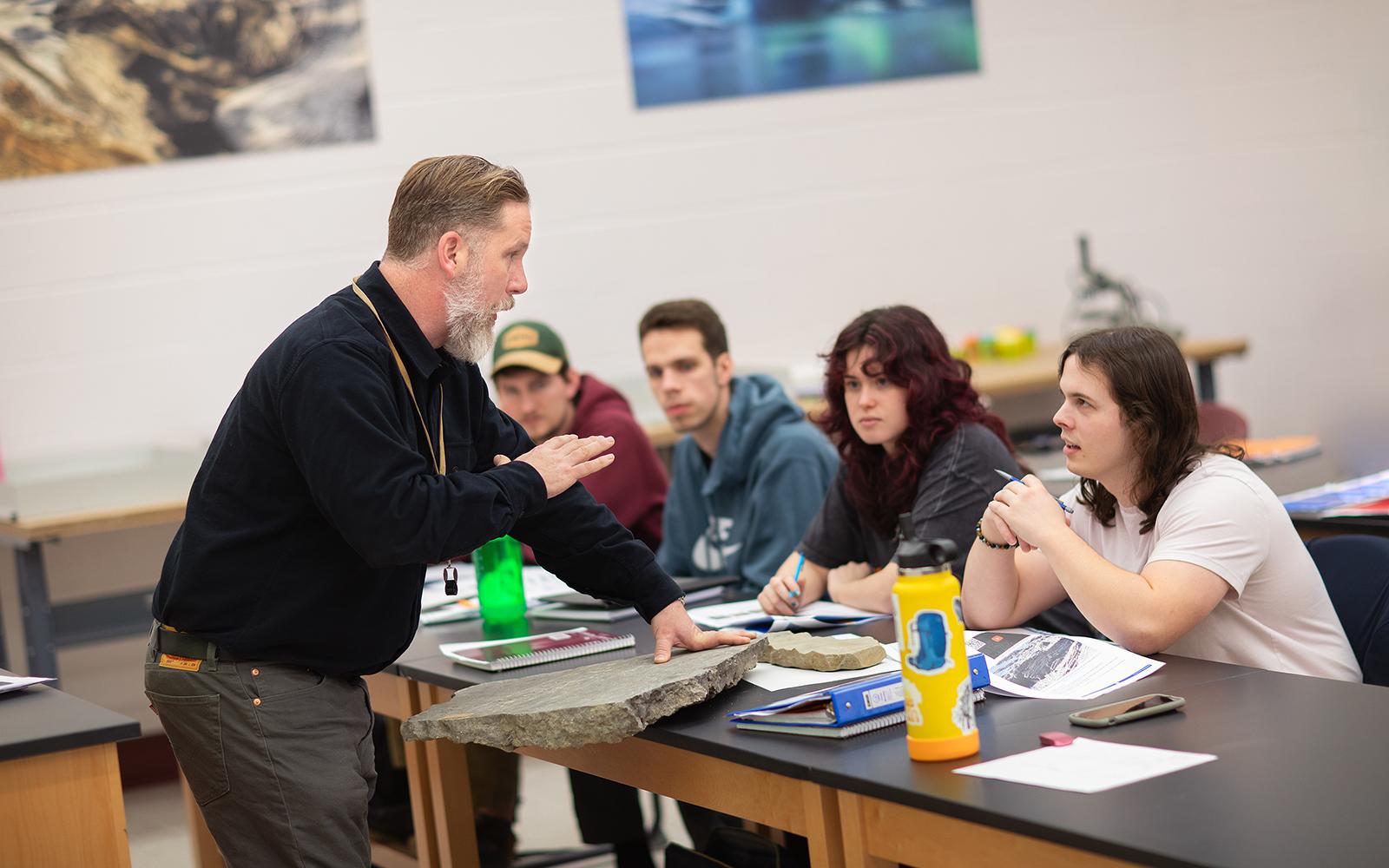To better meet the needs of their students, two professors have blazed a new path at SUNY Potsdam—creating a visually compelling open education resource (OER) textbook for their geology students.
For years, Dr. Michael Rygel and Dr. Page Quinton, a dynamic duo in the Department of Earth and Environmental Sciences, have continued to push the envelope and think outside the box. They have provided students with numerous field research opportunities, built a unique Geoscience Garden on campus, and have now crafted a textbook specifically to meet the needs of their geology students.

From left, Mike Rygel and Page Quinton.
“There are a few mainstream textbooks out there that cover the subject material, but they have significant problems. Overall, I’d say that they are expensive, several decades old, generally in black and white with low-quality photo reproduction, and written at a time when this subject was covered over two semesters, where one semester is standard now. That means students are paying a significant amount of money (around a $300 list price) for a book that they might only use half the time," Rygel explained.
The pair began working on the book, “Sedimentary Geology: Rocks, Environments and Stratigraphy,” in May of 2023, and have rolled it out this semester in Rygel’s fittingly named Sedimentary Geology class. “I was trained to look at sedimentary rocks to determine ancient environments and processes; Page was trained to use the fossils and geochemical clues contained therein to make even more detailed interpretations. That overlap in our research is what fueled our joint interest in improving teaching materials for this content area,” he said.
This semester, students in his 300-level class, a hybrid lecture, and lab, are benefiting from the new textbook, which features images taken by Rygel during his field research with Quinton and former students in the geology program. The new textbook is also being utilized unconventionally, helping to enhance the student experience. “Rather than running it as a traditional lecture, I’m doing the flipped classroom approach where I ask the students to come to class having read the relevant material and ready to discuss. When they show up to class, instead of me lecturing at them, we can spend our time discussing examples/photographs and doing exercises that build on the theoretical knowledge they gained from the readings,” he said.
“What makes this unique is that we wrote the whole thing and created illustrations that are tied to the text. We knew we wanted to make the textbook an open resource so that there was minimal cost to the students, and we know how important it is to have good material easily accessible to the teaching community."
SUNY Potsdam Geology Professor

Rygel and Quinton made a concerted effort to fill the textbook with a significant number of photos and illustrations—helping to paint a picture of the complex geological topics they discuss in class. “The geosciences can be very visually oriented, and we thought a lot about what we wanted to say in each section of the book, then designed illustrations around that. The illustrations paired with written text, allow students with different learning styles to benefit from this text, and the photos used throughout the book allow students to see real-world examples of the things we’re talking about,” Quinton explained.
In addition to the positive impact on STEM students at the College, creating an OER textbook, free of copyright restrictions, will now allow other professors and students from all over the world to utilize this resource. Around 500 images and diagrams populate the new book, which has been released through LibreText, an OER platform where the entire contents of the book are available through a Creative Commons Attribution Share-Alike license.
“This means that anybody can do anything they like with the book, free of charge. There are tons of great geology images on the web, but they are of very little educational value unless you release them via these sorts of licenses.” Rygel said. “When I first started teaching, I would spend hours scouring the internet and the literature for pictures and diagrams that illustrated the topics I was covering. The resources that I found were commonly locked down by copyright restrictions and could only be used in a restricted way. I’m hoping that more people start to think their work this way about.”

Mike Rygel works with students in his Sedimentary Geology class.
Beyond the one Sedimentary Geology class, Quinton said the structure of the book will also her to pull certain sections, such as a chapter on fossils, for her other classes like Principles of Paleontology and Historical Geology, as well as utilize the textbook for her travel courses. “I’ve never assigned required textbooks in my classes because the existing textbooks are typically overwritten with too much material, so the students have a hard time digesting it all, and I don’t organize my class in the same way that the textbook is organized. The figures and diagrams are also not always easy to access for presentations, and the textbooks are expensive. This OER Sedimentary Geology text solves all these problems because it only focuses on the material we want to cover,” she said.
Back in 2020, Quinton and Rygel secured a National Science Foundation grant for a trip to Montana, Texas, and New Mexico where they conducted carbon cycle research with their students. The three-year project allowed Potsdam geology students to immerse themselves in hands-on research, which involved measuring and describing rock outcrops, and collecting samples that were later studied in the geology laboratory at SUNY Potsdam. Content from that research now fills the pages of their new textbook. The grant also provided them with additional funding to be able to write the new textbook.
“Both of us were awarded sabbaticals by SUNY Potsdam and the grant helped cover some of our salary during that time. Because we went with an open access option, students can get the textbook for free online, or if a student wants a print copy, LibreText makes it super easy to order a color copy for less than $30,” Quinton said. “As part of the grant, we needed to engage in broader impacts, these are activities that benefit students and the broader community. This textbook allows us to use the data and samples we collected (e.g. rocks and photos) to be part of educational materials, and not just published scientific papers.”
As they contribute to the collective melting pot of geological information through this new open-resource model of higher education and elevate the classroom experience at SUNY Potsdam, Rygel and Quinton are hoping that more professors around the country will take a similar approach to their pedagogy in the future.
“To the best of my knowledge, there is no comparable OER resource out there for this subdiscipline of geology—which is something that almost every geology degree would require. Given the frustrations that made me start thinking about this in the first place, it’s a bit surprising that nobody beat us to this,” Rygel said. “This is a continually evolving resource and a completely different way of doing things that are free from some of the most cumbersome aspects of more traditional ways of sharing knowledge. This is about teaching, sharing knowledge, and doing my part to try and build a culture of openness and accessibility in the geosciences.”
Article and photos by Jason Hunter
